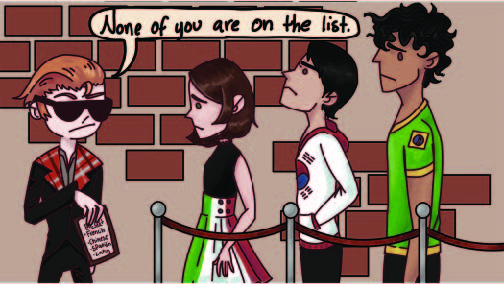When it comes to language courses, McLean offers six to choose from: Spanish, French, Chinese, German, American Sign Language and Latin. This selection offers Highlanders the chance to explore new cultures, but it isn’t enough for a community that is much more diverse than other areas in Virginia.
The World Languages Department must expand its course selection to further integrate the international community at McLean and give all students the opportunity to broaden their horizons.
McLean’s language courses should offer a more accurate representation of students’ origins. Foreign students attending McLean want their culture recognized and shared to feel included at school. Yet, the few language options available show the school’s slow adaptation to a changing county demographic. Languages such as Italian, Russian and Portuguese are left out of the mix. Offering more language courses would help McLean embrace FCPS’ standards of inclusion for students.
McLean’s current language courses deserve their place at the school, but the world’s reality contrasts with what McLean provides. For instance, Japanese, which has over 120 million speakers worldwide and is offered at several other high schools in Fairfax County, is not given any representation in McLean’s curriculum. Making relevant course additions would better expose Highlanders to other cultures.
Academy courses are an option for students who aren’t satisfied with McLean’s language courses, but they impose stressful obstacles on students who decide to take them. The excessive travel time to and from a different school is just one of several unnecessary burdens for students who simply want to learn to communicate in a different language.
I have had students who take Academy courses and are late for their next class, and it’s hard for them because they end up missing one-third of the curriculum,” German teacher Karen Wolpert said.
Even the Academy only offers three additional languages (Korean, Arabic and Vietnamese), which still may not fit a student’s preference. Instead of taking a language course at McLean that they’re not interested in, students resort to external resources, like Duolingo and Babbel, but they tend to be less effective due to the lack of verbal interaction.
“I learn Italian on Duolingo, [which] teaches the basics, but it’s not the same as being in a classroom environment, learning it conversationally,” junior Haley Riggins said. “I can see it and write, but I can’t hear it, so it’s harder to train my ears.”
While adding more language courses would require additional staffing, even one or two more options based on student interest would be beneficial. In an area that is home to countless international families, more options for languages would create an environment that celebrates the multicultural community.
The lack of available courses prevents students from finding what they truly want to master and from learning about cultures that deviate from the standard curriculum. McLean is responsible for accommodating students and their cultures, and they must add more language courses to do so.









